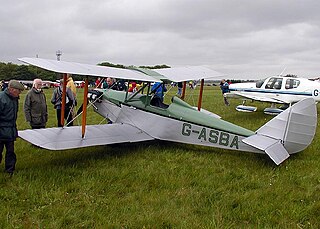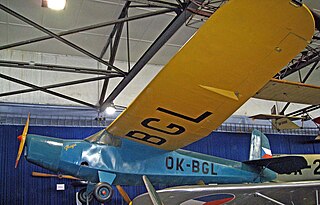
The de Havilland DH.53 Humming Bird is a British single-seat, single-engine, low-wing monoplane light aircraft first flown in the 1920s.

The ANEC I and ANEC II were 1920s British single-engine ultralight aircraft designed and built by Air Navigation and Engineering Company Limited at Addlestone Surrey. One was privately constructed in Brisbane, Australia.

The Beagle Husky was a three-seat British light aircraft built in the 1960s which originated from a Portuguese Air Force requirement for a liaison/training aircraft, a development of the Auster Alpha. It first flew as an Auster design in January 1960, but that company was taken over by Beagle Aircraft in September that year. It was initially available with a 160 hp Lycoming O-320 engine as the Auster D5/160.

The Currie Wot was a 1930s British single-seat aerobatic biplane aircraft. Plans were sold for home building of the aircraft.

The Avions Fairey Junior, also known as the Tipsy Junior was a single-seat light aircraft built in Belgium following World War II.

The Praga E.114 was a single-engine sport airplane, designed and manufactured by the Czechoslovakian company ČKD-Praga. Due to its light weight it was also called Air Baby.

The Edgar Percival E.P.9 was a 1950s British light utility aircraft designed by Edgar Percival and initially built by his company, Edgar Percival Aircraft Limited and later as the Lancashire Aircraft Prospector by the Lancashire Aircraft Company.

The Elliotts of Newbury EoN or Elliotts EoN A.P.4 was a 1940s British four-seat touring monoplane aircraft built by Elliotts of Newbury.

The Zlín Z-XII was a Czechoslovak two-seat sports aircraft, and the first major design success by the Zlínská Letecká Akciová Společnost (Zlín) aircraft manufacturing company, after its founding in Otrokovice after the takeover by the Bata Group.

The Isaacs Fury is a British homebuilt sporting biplane designed by John Isaacs as a seven-tenths scale replica of the Hawker Fury fighter.

The Great Lakes Sport Trainer is an American biplane trainer and aerobatic aircraft. It was originally produced in large numbers before the company building it went bankrupt in the Great Depression in 1933. Owing to its continuing popularity, however, it was eventually placed back into production in the 1970s and again in 2011 by WACO Classic Aircraft.

The Avro 562 Avis was a two-seat light biplane designed and built by the A.V.Roe and Company Limited at Hamble for the 1924 Lympne Light Aeroplane Trials.

The Nash Petrel also known as the Procter Petrel is a two-seat aerobatic or glider tug aircraft. It was designed for amateur production by Procter Aircraft Associates of Camberley, Surrey, England. By the time the aircraft first flew, Procter had changed ownership and had been renamed Nash Aircraft Ltd.

The Gloster Gannet was a single-seat single-engined light aircraft built by the Gloucestershire Aircraft Company Limited of Cheltenham, United Kingdom, to compete in the 1923 Lympne Trials. Engine development problems prevented it from taking part.
The Westland Woodpigeon was a British two-seat light biplane designed to compete in the 1924 Lympne light aircraft trials.
Chilton Aircraft Ltd was a British aircraft design and manufacturing company of the late 1930s and 1940s.

The Chrislea L.C.1 Airguard is a 1930s British two-seat cabin monoplane, designed by R.C. Christophorides and B V Leak, and built by Chrislea Aircraft Limited at Heston Aerodrome.

The Ambrosini Rondone is an Italian-designed two/three-seat light touring monoplane of the early 1950s.
The Watkinson Dingbat was a 1930s British ultralight monoplane designed by E.T. Watkinson and C.W. Taylor.

The Tipsy B was a small sports two-seat monoplane designed by Ernest Oscar Tips, and built in both Belgium and the UK. A total of 42 was built, and a few are still flying.


















